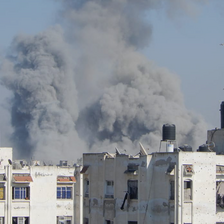The Electronic Intifada 6 August 2024

Displaced Palestinians wait to get water from a traditional water well, which was dug inside a camp to accommodate the displaced in Deir al-Balah, in the central Gaza Strip, 15 May.
APA imagesFood airdrops are not an effective means of alleviating the threat of famine affecting at least a quarter of the 2.3 million people in Gaza.
Israel’s strategy seems to be to starve Palestinians to death, with full support from the United States.
There are influencers on social media sites that share what is going on in Gaza only for attention. Our famine is not content!
World, wake up, we die while you are posting.
One airdrop of humanitarian aid killed Palestinians on the ground when the parachute failed to open.
“Oxfam does not support US airdrops into Gaza, which would mostly serve to relieve the guilty consciences of senior US officials whose policies are contributing to the ongoing atrocities and risk of famine in Gaza,” said Scott Paul, Oxfam’s associate director for peace and security.
Dave Harden, a former official of the US Agency for International Development, said on X: “Air drops are inefficient, expensive, dangerous, and only helpful when there are no other delivery options. Air drops are primarily for the Biden administration’s benefit — to paper over a massive policy failure.”
Living amid famine
“The first thing children do when they hear or see the aid planes, they come out of tents to see what the planes will throw. Will they get something?” Baraa Muhammad said of airdrops in Hamad City in Khan Younis.
Muhammad said she had to carry her baby while running to get to the aid box that had fallen on her family’s land, joining her father, brother and an aunt’s sons in chasing the aid as “people came from everywhere to get” it.
“We got things not considered aid – 5 kilograms of sugar and milk and chocolate – things that are considered accessories,” she said.
Water becomes a luxury
More than 4,000 people live in Qizan al-Najjar, a village in the southeast area of Khan Younis, with displaced people perhaps now outnumbering permanent residents.
Since the beginning of the genocide, people have been transporting water to their homes from distant sources. It is an arduous task, but there is no other choice.
On 17 July, at 1 pm, government water hoses came to the neighborhood for the first time since the Israeli genocide began.
Happiness overwhelmed the neighborhood.
I was out buying some things for the house and when I arrived home, I was happy because my siblings were smiling about the water. This would be only short-term euphoria, but if everything works out, the water delivery will be once a week.
When the truck came, my siblings collected everything we had that could be used to hold water and began to fill the containers.
I went to finish doing the laundry; my siblings went for showers. This was the first time in a long time that we were able to take showers. However, cleaning materials have not been allowed into the Gaza Strip, and we are dependent on what detergents we can round up.
One recent afternoon my brothers went outside to play soccer with their friends and found that everyone was happy due to the abundance of water we now had access to.
“There is water in the spout!” the 5-year-old son of a neighbor exclaimed.
All this happiness is over water for washing and cleaning.
What will we do when drinking water becomes available?
Donya Ahmad Abu Sitta is a writer in Gaza.





